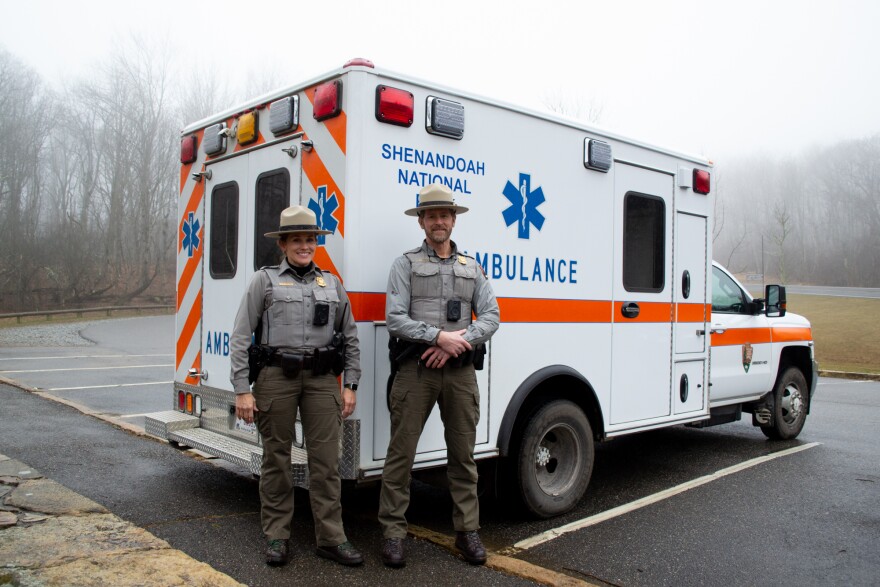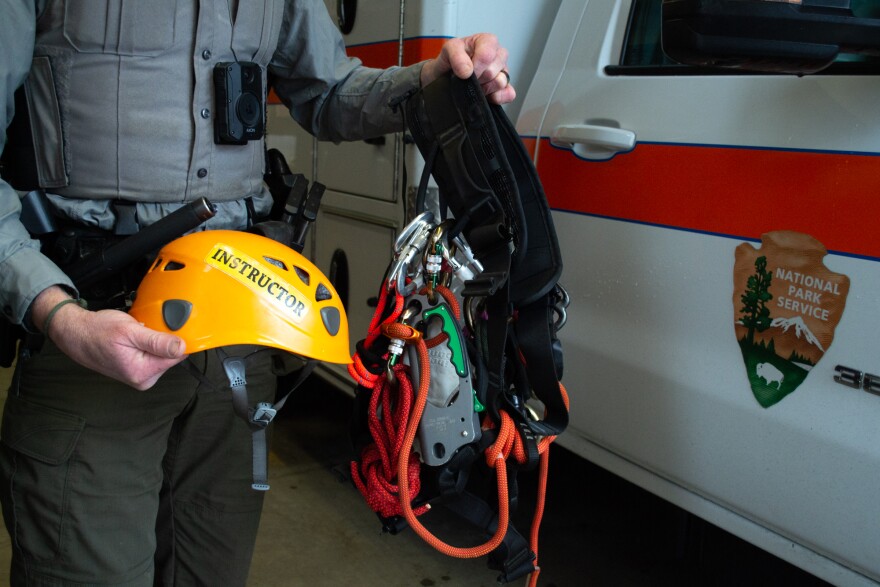Read the original story on the WMRA website.
When someone gets lost or has an accident in Shenandoah National Park, the rangers coordinate their rescue.
Kevin Moses, the park's supervisory ranger, said the main types of emergencies they respond to are people who are injured, ill, lost or stranded. And many of those calls are preventable, to some degree.
"Part of the preventable nature of some of these rescues is decision-making, and what we love to see our visitors do is some research," Moses said.
That includes both researching the trail you plan to hike and knowing what equipment to take.
The National Park Service has a list of "Ten Essentials," which includes first-aid supplies, food, water, a physical map and multiple light sources. Moses said he regularly runs into hikers with little more than their cell phones and added that it's important to take hiking seriously.
"They're fun, but they're pretty hard hikes. There's a lot of elevation change, creek crossings, that kind of stuff," he said. "What if I trip? What if I become injured? What if I become a little bit disoriented, a little bit lost, and I am now hiking at nighttime?"
Chief Ranger Cynthia Sirk-Fear said that rescues can be initiated in a couple different ways — sometimes the person in need calls 911 or flags someone down on the trail. Other times, a loved one who knows their itinerary will call to say they haven't made it home.
Once the rangers have an idea of where someone is, "[t]he typical response then is to get that initial person as quickly as possible to the individual, so that we can confirm location, confirm the injury, just gather all of that data that we're going to need to develop the plan," Sirk-Fear said.

Jared Goodson is a 21-year-old college student from Manassas, who hiked Old Rag Mountain by himself in December.
"I go hiking a lot, and I take videos on the edge of the cliffs for my girlfriend, just to get her heart racing and stuff," he said. "So, I was taking a video, and my hat fell off onto a tree branch on the edge of the cliff. … I lower myself down onto the tree branch. … Once I got my hat, I turned around to the cliff edge, but I couldn't reach the top anymore. … When I lowered myself to jump, the tree branch broke."
Goodson fell for a while, hit a rock ledge, rolled, kept falling, hit a number of small branches and finally landed on the ground. Moses said Goodson fell 170 feet in total.
When Goodson landed, he started conducting a full body check. His neck seemed OK. Then, he got to his left leg.
"When you see a dislocated ankle, it's really, really ugly. It's really, really painful, so that kind of sent me into a panic," he said. "So, then I started screaming for help for maybe 15 or 20 minutes with no response."
He was able to drag himself to a location where he got service on his Apple watch and called 911. It still took about three hours before the first responders and other hikers were able to find him. Secured in a stretcher, Goodson was hoisted back up the cliff with ropes and then carried down Old Rag by a team of about 20 rangers and volunteers.
An ambulance took him a Charlottesville hospital, where he underwent surgery to put his ankle back in place.
"A hundred-foot fall is supposed to be a non-survivable action, and I didn't break a bone," Goodson said. "I only dislocated my ankle. So, God was really with me that day."

The rangers explained that not everyone is so lucky. A few years ago, four friends were out hiking and left the trail to explore the top of a waterfall. One of them stepped on a wet patch of rock.
"He fell 82 feet … hitting ledges, and he landed face down in a three-foot pool of water," Moses said. "One of his super dedicated buddies, he saw it. He was horrified, he ran to the edge of the waterfall thinking he was going to help him, and he fell, too. The exact same path."
The other two ran to the base of the waterfall and pulled their friends out of the water. But it was too late for one of them, who died.
Falls are a relatively common accident in the park. In another incident, two young women were taking selfies from the top of a waterfall when they fell.
"They were both very severely injured," Sirk-Fear said. "They ended up being hoisted out and they were both flown to the hospital, and if I recall, spent about 30 days in the hospital due to the severity of their injuries."
Both survived.
As he recounted these stories, Moses heaped praise upon their dispatchers: "Those are the heroes on the other side of the microphone."
As for Goodson, he's on the road to recovery, albeit on crutches. But he said the experience changed him.
"I'm more appreciative of every moment I'm in. Like, the bed feels softer at night, and my girlfriend's hair smells better in the morning," he said. "If you see a first responder, just say, 'Thank you,' or maybe do something nice for them. … They're heroes."


